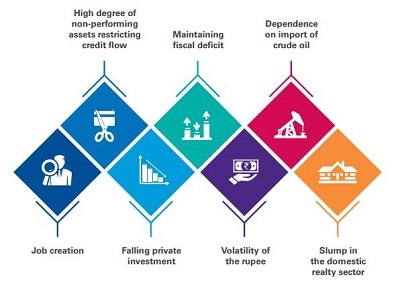Context:
The Indian economy presents a complex picture of both achievements and challenges, embodying a dualistic and contradictory nature. Currently, debates over economic performance have intensified, with the government and the Opposition exchanging claims and counterclaims. In this contentious atmosphere, accurately assessing the true state of the economy becomes a formidable task, as it does not clearly indicate either strong growth or imminent collapse.
The Dichotomy of Growth:
One facet of the Indian economy portrays a narrative of growth and promise, epitomized by indicators such as the size and trajectory of GDP, reduction in poverty, and buoyant stock market indices. The government emphasizes these aspects to bolster its claims of successful economic management. India's GDP growth, outpacing many emerging economies, propels it towards becoming the world's third-largest economy. Moreover, the purported reduction in poverty, attributed to inclusive policies, and the flourishing stock market signal an era of entrepreneurship and wealth creation.
Additionally, high-frequency indicators like passenger car sales, domestic air travel, and increased participation in financial markets further bolster the narrative of upward mobility and economic dynamism. For instance, the surge in passenger car sales and domestic air passengers underscores a burgeoning middle class with increasing purchasing power. Similarly, the proliferation of demat accounts and investments in mutual funds reflects a growing investor base eager to partake in India's economic ascent. However, alongside these glimmers of prosperity, a contrasting reality of economic dualism persists, challenging the narrative of unbridled growth.
The Persistence of Dualism:
Despite the veneer of progress, the Indian economy grapples with deep-rooted dualism, manifested in the coexistence of prosperity and deprivation. While certain segments thrive, a significant portion of the population remains marginalized, reliant on welfare programs for sustenance. The extension of the free food grain distribution program and the surge in demand for rural employment under MGNREGA underscore the persistent divide between the affluent and the marginalized.
Moreover, the disproportionate reliance on agriculture and the stagnation of rural incomes exacerbate the dualistic nature of the economy. Real wages in both agricultural and non-agricultural sectors have either stagnated or declined, perpetuating disparities and indebtedness among rural households. Despite the ostensible growth in urban areas, rural distress persists, underscoring the entrenched inequalities within the Indian economic landscape. This dualism is further exemplified by the proliferation of speculative trading in financial markets, which, instead of fostering sustainable wealth creation, exacerbates volatility and exacerbates financial insecurity among retail investors.
Challenges and Concerns:
Amidst the rhetoric of growth and progress, India faces formidable challenges that threaten to derail its trajectory towards sustainable development. The surge in speculative trading and the alarming rate of losses incurred by retail investors raise concerns about the stability and inclusivity of India's financial markets. Additionally, the specter of failing to meet Sustainable Development Goals (SDGs) looms large, casting doubts on the efficacy of India's growth model.
As India hurtles towards becoming the world's third-largest economy, it must confront the dualism and contradictions that plague its economic landscape. The persistence of rural distress, coupled with burgeoning urbanization, underscores the urgent need for holistic policy interventions that prioritize inclusive growth and equitable development. Failure to address these underlying disparities risks undermining India's aspirations for global leadership and casts a shadow over its economic future.
Conclusion:
In conclusion, the Janus-faced nature of the Indian economy encapsulates a paradoxical reality, characterized by simultaneous narratives of growth and deprivation. While indicators of GDP growth, stock market performance, and consumption trends paint a picture of progress and dynamism, the underlying dualism and inequality reveal a starkly contrasting tale of marginalization and stagnation. As India charts its course towards becoming a global economic powerhouse, it must confront these contradictions head-on, prioritizing inclusive policies that uplift the marginalized and foster sustainable development. Failure to address these underlying fissures risks jeopardizing India's economic future and thwarting its aspirations for equitable growth and prosperity.
|
Probable Questions for UPSC Mains Exam
|
Source – The Indian Express







